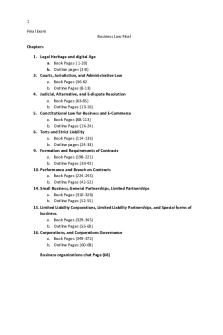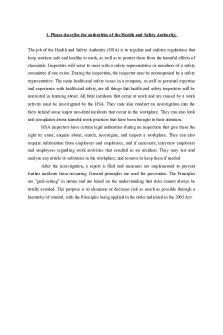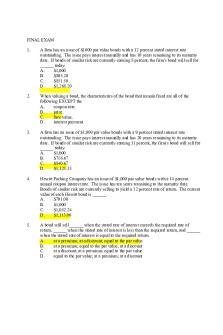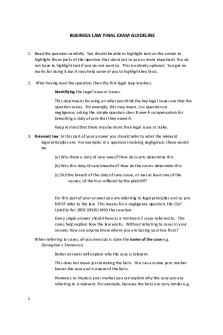Business Law - Final Exam Guideline PDF

| Title | Business Law - Final Exam Guideline |
|---|---|
| Course | Business Law |
| Institution | The University of Notre Dame (Australia) |
| Pages | 6 |
| File Size | 149.7 KB |
| File Type | |
| Total Downloads | 32 |
| Total Views | 173 |
Summary
Guideline and practice for the final exam...
Description
BUSINESS LAW FINAL EXAM GUIDELINE
1. Read the question carefully. You should be able to highlight text on the screen to highlight those parts of the question that stand out to you as more important. You do not have to highlight text if you do not want to. This is entirely optional. You get no marks for doing it but it may help some of you to highlight key facts. 2. After having read the question, then the first legal step involves: Identifying the Legal Issue or Issues. This step means focusing on what you think the key legal issues are that the question raises. For example, this may mean, in a question on negligence, asking the simple question does B owe A compensation for breaching a duty of care that they owed A. Keep in mind that there may be more than legal issue at stake. 3. Relevant law. In this part of your answer you should refer to what the relevant legal principles are. For example, in a question involving negligence, these would be: (a) Was there a duty of care owed? How do courts determine this. (b) Was this duty of care breached? How do the courts determine this. (c) Did the breach of the duty of care cause, or was at least one of the causes, of the loss suffered by the plaintiff?
For this part of your answer you are referring to legal principles and so you MUST refer to the law. This means for a negligence question, the Civil Liability Act 2002 (NSW) AND the case law. Every single answer should have as a minimum 2 cases referred to. The cases help explain how the law works. Without referring to cases in your answer, how can anyone know where you are basing your law from? When referring to cases, all you need do is state the name of the case e.g. Donoghue v Stevenson. Better answers will explain why the case is relevant. This does not mean just restating the facts. You can assume your marker knows the case and is aware of the facts. However, to impress your marker you can explain why the case you are referring to is relevant. For example, because the facts are very similar e.g. 1
as both the case and the facts of the question both refer to a manufacturer or some other relevant point.
4. Application of law to the facts. This is the really key part of your answer. What you are doing here is showing your examiner that you do understand how the law works and how it applies to the actual facts of the question. This is when you say that B owes a duty of care to A as B was the manufacturer of a product that A used and B breached their duty of care because they failed to exercise a reasonable degree of safety because.... Risks too high, danger too great, could have avoided danger by minimal effort etc. Mentioning the cases again is very useful here if you can show how they directly apply to the facts. Try to consider the law from both sides and consider any possible defences
5. Conclusion. In your answer you need to come to a conclusion. As an adviser, your clients will expect you to tell them what you think is likely to happen. Your examiner will also expect this. Do not sit on the fence. Remember, someone has to win and someone lose in every single court case and so pretend this case has gone to court. What will the court decide? You do need to also state the remedies as best as you can work them out to be. For example A wins as B has breached their duty of care in negligence and B has to pay $100,000 in compensation.
2
EXAMPLE 1
BOZ V RE-GROWTH HAIR PTY LTD Re-growth Hair Pty Ltd make a product entitled ‘Regrow Hair’, a product it claims can actually regrow hair. This product has been heavily advertised on television, the internet and in the daily newspapers all around Australia. Regrow Hair is a product that claims to be made using a special formula. The product is very popular with its targetted demographic (30+ to middle aged males). The following is placed on the label of each bottle: Regrow Hair It works! 100% Natural! 600ml of Hair Regrowth magic in every bottle 100% Pure and natural ingredients. Secret Formula guaranteed to regrow hair Please dispose of after use and help keep Australia beautiful. Re-growth Hair Pty Ltd
Product of Australia
Boz, who is in his late 20s, has started to notice some worrying signs of hair loss and whilst enjoying a lazy afternoon at Coogee, notices a shop advertising for sale the Regrow Hair product and so he decides to discreetly purchase a bottle of the ‘Regrow Hair’ product from this shop at Coogee. He does not buy the product direct from Re-growth Hair Pty Ltd and so he has no contract with that company. Boz paid $20 for the bottle and thought to himself at least this is cheaper than having to buy a hairpiece and have it groomed for the rest of his life (like the ex-Australian cricketer Shane Warne has to do). Boz starts to use the product but after a few weeks does not notice any improvements with his hair problems (and if anything things are getting slightly worse) and decides to ask a friend with a chemistry degree to carry out a basic chemical analysis of the Regrow Hair product. Boz is horrified to hear back from his friend that the Regrow Hair product is made up of essentially 100% saline solution and has some added artificial colouring dyes. Boz wants to take legal action against Re-growth Hair Pty Ltd.
3
Advise Boz and Regrowth Hair Pty Ltd what their rights would be in this legal dispute under section 18 and any other section of the Australian Consumer Law you think relevant. Boz is not wanting to take any legal action against the shop at Coogee. Section 18 of the ACL may apply but Rupert must establish that the following elements are satisfied: 1.
He must first establish that Re-growth Hair Pty Ltd is a Person.
2.
That Re-growth Hair Pty Ltd is acting within trade or commerce.
3.
That Re-growth Hair Pty Ltd has Engaged in Conduct
4. That the conduct that Re-growth hair Pty Ltd has engaged in is Misleading or Deceptive. Re-growth Hair Pty Ltd is a corporation and so is a legal person and so it is a person. Regrow Hair Pty Ltd is a manufacturer of this product and these products are being sold commercially and so the company is acting in trade or commerce. Regrow Hair Pty Ltd has engaged in conduct by allowing this label to be placed on its bottles containing the solution it has manufactured. The label is misleading or likely to mislead or deceive consumers in that it contains an express statement that it works. Similar to the 20th Century Fox v SA Brewing case (re Duff beer) as by implication the consumer would think they are buying a product which is likely to help their hair loss issues. Taking the objective approach used by courts the most likely target market for this product would be males aged from their 30s to middle age. It is very likely that a significant proportion of persons reading the label (males of this age suffering hair loss issues) would be led into error or are likely to be led into error by the claims being made on the label of this product (that it works!). Similar to Forwood Products Pty Ltd v Gibbett as there is also here an express written misrepresentation about the product being sold i.e. that it Works, when the ingredients suggest otherwise, would constitute misleading and deceptive conduct. Is there any evidence that the product works? Very doubtful. No such product seems to exist. No defences apply if the conduct is seen as misleading.
4
An injunction could be sought under s216, 232-235, so that Re-growth Hair Pty Ltd must stop selling their ‘Regrow Hair’ product until they change the labelling. Additionally, under s236 a refund of the product price may be sought by Boz. If Boz has suffered any other form of loss e.g. any adverse medical reaction (but this is not indicated on the facts) then he is also likely to be entitled to compensation for these other losses under section 236. Due to the flase and misleading claims being made, a corrective advertising order is also likely to be ordered under s246 against Regrowth Hair Pty Ltd (as was seen in the Coca-Cola case). Contract law actions and claims under s54 and s55 are NOT relevant as the facts make it clear that Boz has no contract with Re-growth Hair Pty Ltd and that he does not want to sue the shop in Coogee. There is also no suggestion of unsafe goods on the facts (no harm was suffered by Boz). Issues can be raised about the manufacturer’s liability provisions contained in section 271 as the goods here do not appear to be fit for the purpose for which they are required and so are arguably not of acceptable quality per s 271(1), (the product does not cause hair to regrow) and also the goods do not match any description given of them (per s271(3)). A remedy would also be available to the consumer for a breach of these provisions.
EXAMPLE 2
NEGLIGENCE
It was late at night and very wet and, rather than wait for a taxi to take her home, Anna was only too happy to accept a lift from Michael. He smelt strongly of alcohol and had trouble keeping the vehicle on the road. Anna decided to continue the journey as it was raining very heavily. Shortly after, Michael lost control of the vehicle and hit a tree, leaving both him and Anna seriously injured. Will Anna be able to successfully sue Michael in negligence? What does Anna need to establish in order to succeed in such an action? Are there any defences that Michael could raise under the civil liability legislation in relation to Anna’s negligence claim? Discuss. This question is concerned with the principle of voluntary assumption of risk and the effect it has on a claim in negligence. Anna has an action in negligence as it is clear that the driver of a motor vehicle owes a duty of care both to their passengers and to other road users. By driving a vehicle while drunk, the driver is in breach of that duty of care. If the passenger or other road user is injured 5
because of the driver’s drunken conduct, then there should be little problem establishing the questions of causation and remoteness of damage. However, the injured party may be faced with the problem of the driver raising the defences of voluntary assumption of risk, which is a complete defence, and contributory negligence, where fault is shared between the parties. It is possible for contributory negligence to effectively be a complete defence where an injured party can be found to be 100 per cent contributorily negligent. Voluntary assumption of risk occurs where the plaintiff positively consents to assume the risk of injury, thus absolving the other party from their duty of care and consequent liability to pay compensation. There must not only be knowledge of the risk but also an appreciation of its dangerous qualities and a voluntary acceptance of that risk. In this type of defence, what is of critical importance is the degree of the driver’s intoxication. When does it reach the point that accepting a ride with knowledge of the driver’s condition implies assumption of the legal risk of any future negligence? Two possible situations could arise: firstly, when the driver is so drunk as to be incapable of driving safely; and secondly, when the passenger has been warned by the driver that they will be driving in a dangerous manner. From the facts in this question, it appears that Anna would be met with the defence of voluntary assumption of risk. She was aware that Michael was drunk, that the chances of an accident were high, and that she could have got out of the car at the first stop if she had wanted to. It appears that there was not only knowledge of the risk but also an appreciation of the dangers involved and a voluntary acceptance of those risks. To determine whether or not a plaintiff has been contributorily negligent, the standard of care is based on a reasonable person in the position of the plaintiff, and the matter will be decided on the basis of what the person knew or ought to have known at the time. There is a presumption of contributory negligence if the person who suffers harm is intoxicated, or if the person who suffers injury was relying on the care and skill of a person they knew to be intoxicated. Even if the defence of voluntary assumption of risk fails, contributory negligence will certainly apply, and the question would be to what percentage a court would be prepared to hold Anna responsible for her actions.
6...
Similar Free PDFs

Business LAW Final EXAM
- 70 Pages

Business Law Final Exam Study Guide
- 42 Pages

Taxation LAW Final EXAM
- 8 Pages

Law Final Exam 2021
- 4 Pages

Business Law Exam 2 Notes
- 8 Pages

Final exam thames business math
- 5 Pages

Introduction to Business-Final Exam
- 33 Pages

Business Law and Practice MCQ final
- 24 Pages
Popular Institutions
- Tinajero National High School - Annex
- Politeknik Caltex Riau
- Yokohama City University
- SGT University
- University of Al-Qadisiyah
- Divine Word College of Vigan
- Techniek College Rotterdam
- Universidade de Santiago
- Universiti Teknologi MARA Cawangan Johor Kampus Pasir Gudang
- Poltekkes Kemenkes Yogyakarta
- Baguio City National High School
- Colegio san marcos
- preparatoria uno
- Centro de Bachillerato Tecnológico Industrial y de Servicios No. 107
- Dalian Maritime University
- Quang Trung Secondary School
- Colegio Tecnológico en Informática
- Corporación Regional de Educación Superior
- Grupo CEDVA
- Dar Al Uloom University
- Centro de Estudios Preuniversitarios de la Universidad Nacional de Ingeniería
- 上智大学
- Aakash International School, Nuna Majara
- San Felipe Neri Catholic School
- Kang Chiao International School - New Taipei City
- Misamis Occidental National High School
- Institución Educativa Escuela Normal Juan Ladrilleros
- Kolehiyo ng Pantukan
- Batanes State College
- Instituto Continental
- Sekolah Menengah Kejuruan Kesehatan Kaltara (Tarakan)
- Colegio de La Inmaculada Concepcion - Cebu







